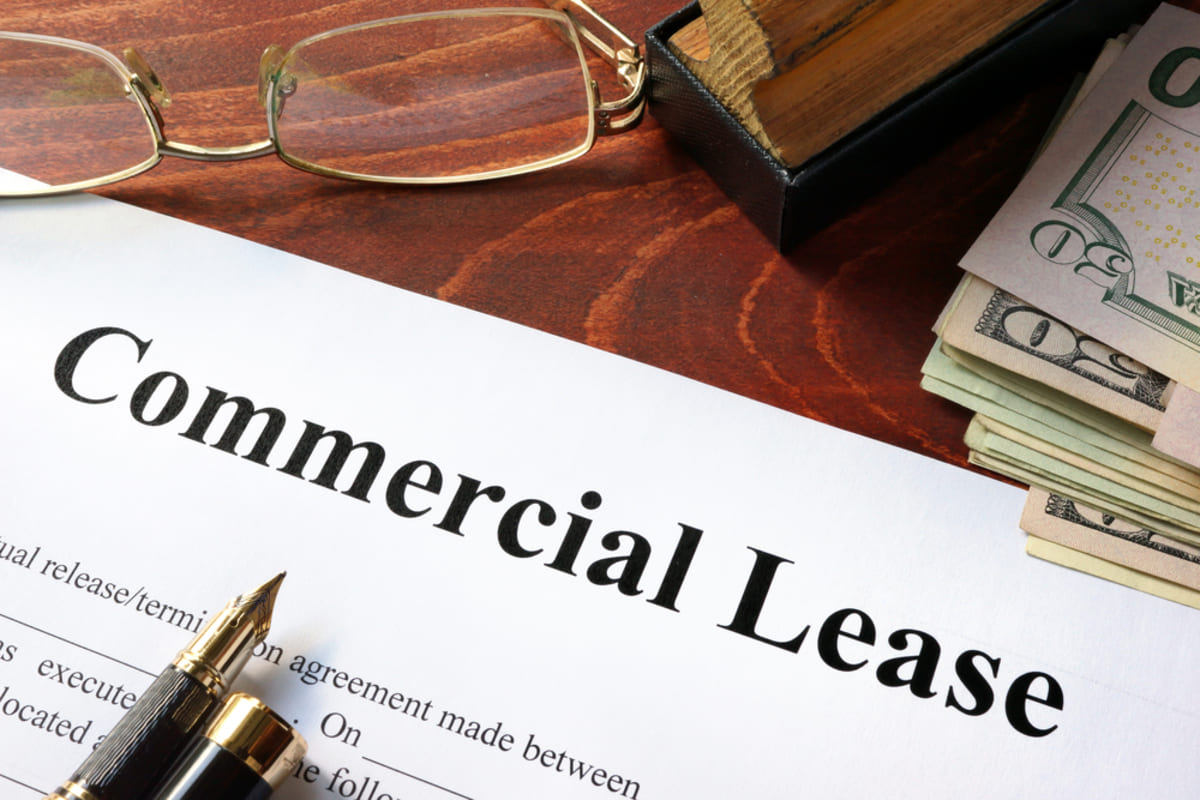Investor Resources
Decoding Your DC Commercial Property Rental Agreement

A lease agreement for commercial property investment can be complex, filled with jargon and fine print that could make your head spin.
Don't worry; this blog will provide the necessary information to understand commercial leases and make informed decisions.
It will guide you through commercial leases, illuminating the way with practical advice and clear explanations. Our team at Kenwood Management Company will cover everything from understanding key elements such as square footage costs and lease types to navigating different state laws.
Understanding Lease Agreements for Commercial Property
A commercial rental agreement is a significant arrangement between landlord and prospective tenant, especially when the space is for retail, office, or industrial purposes. This isn't your average residential rental deal—it's more complex and often requires professional help.
In this context, expenses like 'base rent,' 'lease term,' and 'triple net (NNN)' pop up frequently.
For instance, the annual rent of commercial property doesn't come out of thin air; it's calculated based on the price per square foot ($/SF) plus any NNN expenses that come into play.
The Importance of Square Footage in Leases
Square footage becomes particularly significant in commercial leases because businesses need enough room to operate efficiently.
An office space of 1000 square feet priced at $20 per square foot annually would amount to an annual expenditure of $20,000 before factoring in additional costs.
Different Types of Commercial Leases
Triple-net leases have been discussed before, yet it is essential to note that they are only one of the focuses in this context. There are multiple types, such as gross lease, where tenants pay fixed monthly rents while landlords cover most property expenses, including real estate taxes or maintenance fees.
Another one worth mentioning is a modified gross lease, which falls somewhere between these two extremes, allowing both parties to share certain additional expenses.
Key Elements of a Commercial Lease Agreement
A Washington, DC, rental lease agreement is more than just renting space. It's a legal commitment; understanding its key elements can save you from unwanted surprises.
Understanding Common Area Maintenance in Leases
One essential component is Common Area Maintenance (CAM). CAM fees cover costs for maintaining common areas like hallways, bathrooms, and parking lots. Usually, these expenses are shared among multiple tenants based on their proportionate square footage.
In NNN leases, tenants pay their share of property taxes, insurance premiums, and CAM fees. On the other hand, gross leases include all these costs within the base rent, making it easier for businesses to budget month-to-month expenses.
The Importance of Personal Guarantee in Leases
A personal guarantee ensures that if your business fails to meet lease obligations—unpaid rent or damage repairs—you’re personally liable to cover those costs. Landlords often ask this from new businesses without proven track records.
Including such terms means leasing commercial property carries risks beyond your company's financial health; your assets could be at stake.
Unlike residential agreements where rental term durations typically last 6-12 months. Most commercial lease agreements span over several years, commonly between 3-10 years, with options available for renewal at predetermined rates.
Some tips to consider:
-
Analyze every aspect before signing any contract.
-
Hire a real estate attorney specializing in commercial properties to review and explain complicated legal terms.
-
It's important to note that every aspect of a commercial lease is open to negotiation. Therefore, it is advisable to be confident when advocating for more advantageous terms.
The decision to sign a lease should never be taken lightly. With a thorough understanding and careful negotiation, you can secure an agreement that supports your business goals while limiting potential risks.
Types of Commercial Lease Agreements
Understanding the types of lease agreements is critical for commercial real estate. Each type carries unique characteristics and conditions that can significantly impact your business operations.
Diving into Office Leases
An office lease allows a tenant to rent space specifically for business activities. It's not just about square footage; additional terms like a security deposit and standard area maintenance also play significant roles. The office lease agreement typically includes provisions on who pays for these expenses.
The most common type among office leases is the gross lease. In this setup, tenants pay a fixed monthly rent while landlords cover property expenses such as real estate taxes or building insurance coverage.
However, each lease is unique. Read every line carefully before signing any deal with your landlord or tenant.
Unpacking Industrial Space Leases
Moving onto industrial spaces, we encounter another breed of leases tailored towards manufacturing purposes. These are often larger in scale than standard office leases due to increased usable space requirements for production lines and storage facilities.
A net lease is a popular choice where tenants shoulder some property costs alongside their base rent payments. This may include facility event space rental agreement charges if events form part of their operation structure.
In Washington, DC, where our team here at Kenwood Management Company operates, many businesses opt for modified gross contracts as they provide a balance between predictability and shared responsibility with landlords. In these setups, specific details determine which party handles certain operating expenses—from heating bills to parking lot repairs.
Washington DC Rental Lease Agreement
In our experience at Kenwood Management Company, we've noticed that commercial leases in Washington, DC, tend to have some unique elements compared to other regions like West Virginia or North Carolina.
In particular, tenants often pay property expenses such as real estate taxes and CAM costs—things that might not always fall onto the tenant elsewhere.
The square footage calculation also differs slightly; it tends towards "usable" rather than "rentable." This ensures businesses only shell out cash for actual working spaces, not just any random additional areas within the building complex.
For example, a company leasing 1,000 square feet may find they only really use 900 square feet because hallways and lobbies don't contribute directly towards generating revenue.
Paying only for this 'usable' space makes quite a difference when calculating monthly rent.
 Understanding Lease Agreement Terminology
Understanding Lease Agreement Terminology
The language used in commercial leases can often seem confusing and intimidating. Let's cover some essential lease agreement terms that can benefit you and go into more depth into the terms mentioned previously.
Exploring Property Including Terms
For commercial leases, "property including" refers to everything that comes with your rented space. This might be anything from shared amenities such as kitchens or bathrooms (common areas) to utilities or services.
The specifics will vary based on the type of property you are leasing and its location; for example, office spaces typically include more shared facilities than industrial properties. Ask questions about any unclear points in the lease agreement to get a clear picture of what is included in your square foot calculation.
Triple Net Lease (NNN)
A triple net lease (NNN) is a commercial real-estate agreement in which the tenant pays all property-related expenses, such as repairs and maintenance, taxes, utilities, and insurance.
This type of lease places all the responsibility for upkeep on the tenant while providing greater control over budgeting and preventing unexpected costs.
Full-Service Gross and Modified Gross Lease
Full-service gross leases are agreements where the landlord pays for all the operating expenses associated with a rental property. This type of lease is used when renting office spaces and retail locations, as it offers stability and predictability to tenants.
In contrast to triple net leases, where tenants are responsible for all operating expenses, modified gross leases require tenants to contribute to some operating expenses.
This shared responsibility creates a more balanced and flexible leasing arrangement that benefits the landlord and tenant.
Sublease Clause
Sublease clauses are inserted into commercial leases to protect landlords from the potential risks of allowing tenants to rent out part or all of their space. This type of clause allows landlords to maintain control over who can sublet the property and where and for how long it can be rented.
The purpose of a sublease clause is to ensure landlords have a say in who their tenants sublet the space to and how long it can be rented. This helps protect the landlord’s interests while also allowing tenants to use their space efficiently.
Exclusive Right to Sublease
An exclusive right to sublease clause allows tenants to sublease their space without requiring the landlord’s consent. This type of clause can benefit landlords, as it limits their liability and gives them some control over how tenants use their property.
Tips for Negotiating a Commercial Lease Agreement
Sealing the deal on your dream commercial property is no small feat. Getting that lease agreement just right requires careful negotiation.
Strategies for Rent Lease Negotiations
What is the first rule of thumb in any negotiation? Understand what you're negotiating. In a commercial lease agreement, key elements include rent price and payment terms and conditions, length of lease term, space rental details like square feet area, and common types of spaces included, such as office or manufacturing purposes.
When discussing a month's rent price, a crucial factor is understanding how it's calculated—typically based on square footage.
To negotiate with effectiveness, there is a secret: instead of rigidly adhering to them, skillfully manipulate and experiment with these components.
-
Increase the term length but ask for lower annual increases in return.
-
If going down the route of net leases—request caps on certain controllable expenses like maintenance costs or estate taxes, which could skyrocket without warning otherwise.
Commercial rental property comes loaded with other complexities—security deposits being an often—overlooked component during negotiations due to their perceived insignificance compared to bigger-ticket items like base rents.
However, they hold significant value given they offer financial protection against potential damages or breaches by commercial tenants making them another lever in negotiations.
-
Propose reducing this deposit amount if you have a good credit standing, primarily if you can provide an individual credit check as proof.
-
If the landlord is insistent on keeping it high, negotiate for the deposit return without deductions at the lease end, provided there's no default from your side.
Navigate Lease Agreements and Commercial Investment With Kenwood Property Management
Navigating a lease agreement for commercial property investment can seem intimidating. However, with knowledge of the above elements, you can confidently approach negotiations.
At Kenwood Management Company, we simplify commercial leasing for landlords and tenants. Our expertise in property management and investment and our local market knowledge allow us to offer comprehensive services and tailored solutions.
Our dedicated professional team is committed to offering responsive and personal service, making Kenwood Management Company a trusted partner in your commercial property journey.
If you want to learn more about investing in commercial real estate, download our insightful guide, How to Invest in Commercial Real Estate.


